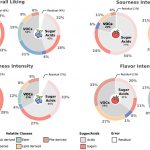Plant Science Research Weekly: March 4, 2022
Review. Auxin canalization: From speculative models toward molecular players
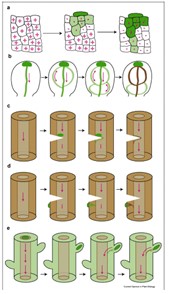 The versatility of roles that the hormone auxin plays led Paque and Weijers to suggest a new meaning to the acronym IAA (originally- Indole Acetic Acid)- ‘Influences Almost Anything’. It is known that PIN-FORMED (PIN) auxin exporters are responsible for cell-to-cell directional auxin flow and auxin induces the co-ordination and polarization of PINs. In their recent review article, authors Hajný, Tan and Friml addresses with some long-standing questions and puts forth some interesting hypothesis regarding the mechanism of auxin canalization. For example, the authors hypothesize that the auxin flowing through the cell and the cell sensing the neighbor with the lowest auxin level determine the positioning of PIN proteins and formation of the canal. Additionally, they say that sub-cellular dynamics of PIN and actin and myosin functions are also required for auxin canalization during vasculature formation and regeneration after wounding. This opinion article is a must-read for every plant biologist. (Summary by Sibaji K Sanyal @SibajiSanyal) Curr. Opin. Plant Biol. 10.1016/j.pbi.2022.102174
The versatility of roles that the hormone auxin plays led Paque and Weijers to suggest a new meaning to the acronym IAA (originally- Indole Acetic Acid)- ‘Influences Almost Anything’. It is known that PIN-FORMED (PIN) auxin exporters are responsible for cell-to-cell directional auxin flow and auxin induces the co-ordination and polarization of PINs. In their recent review article, authors Hajný, Tan and Friml addresses with some long-standing questions and puts forth some interesting hypothesis regarding the mechanism of auxin canalization. For example, the authors hypothesize that the auxin flowing through the cell and the cell sensing the neighbor with the lowest auxin level determine the positioning of PIN proteins and formation of the canal. Additionally, they say that sub-cellular dynamics of PIN and actin and myosin functions are also required for auxin canalization during vasculature formation and regeneration after wounding. This opinion article is a must-read for every plant biologist. (Summary by Sibaji K Sanyal @SibajiSanyal) Curr. Opin. Plant Biol. 10.1016/j.pbi.2022.102174
Review: Embryo-endosperm interactions ($)
 Angiosperm seed formation is an incredibly complex process, considering that it requires coordinating the development of three distinct structures –the embryo, the endosperm and the seed coat– in a small space. However, Doll and Ingram show us that angiosperms faced this challenge by evolving a complex network of interactions between these compartments, especially between the embryo and the endosperm. These two structures rapidly become symplastically isolated after double fertilization, however, this does not impede further communication between these tissues. In fact, several vital processes in seed development, such as nutrient mobilization, embryo expansion and embryo cuticle formation, depend on signaling peptides, phytohormones, and other compounds being exported to the apoplast between the two tissues. Moreover, embryo-endosperm interactions are essential to dormancy acquisition and germination. Further studies are required to understand the nature of the apoplastic interface between the embryo and the endosperm and the molecular and genetic basis that underpins molecule trafficking. Still, this fascinating review surely provides a promising starting point for exciting and new research in this area. (Summary by Carlos A. Ordóñez-Parra @caordonezparra) Annu. Rev. Plant Biol. 10.1146/annurev-arplant-102820-091838
Angiosperm seed formation is an incredibly complex process, considering that it requires coordinating the development of three distinct structures –the embryo, the endosperm and the seed coat– in a small space. However, Doll and Ingram show us that angiosperms faced this challenge by evolving a complex network of interactions between these compartments, especially between the embryo and the endosperm. These two structures rapidly become symplastically isolated after double fertilization, however, this does not impede further communication between these tissues. In fact, several vital processes in seed development, such as nutrient mobilization, embryo expansion and embryo cuticle formation, depend on signaling peptides, phytohormones, and other compounds being exported to the apoplast between the two tissues. Moreover, embryo-endosperm interactions are essential to dormancy acquisition and germination. Further studies are required to understand the nature of the apoplastic interface between the embryo and the endosperm and the molecular and genetic basis that underpins molecule trafficking. Still, this fascinating review surely provides a promising starting point for exciting and new research in this area. (Summary by Carlos A. Ordóñez-Parra @caordonezparra) Annu. Rev. Plant Biol. 10.1146/annurev-arplant-102820-091838
Review. The complex zigzagging in the plant immune system
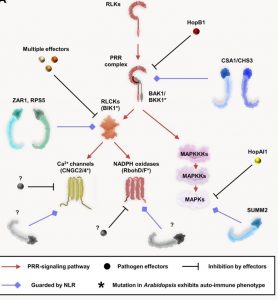 I remember when I joined my PhD lab, the first article I was recommanded was a review by Jones and Dangl (2006) titled “The plant immune system”. Even today it remains the first article given to newbies in the lab. But the field has progressed way ahead in the more than fifteen years since that article was published, with discoveries, new concepts, and even new terminology, so every time we have to share a few more articles for the updates along with the original one. But not anymore, as in a recent review by Ngou, Ding, and Jones, the authors reviewed updates in the field with lots of examples and fresh concepts. First, the authors looked at plant defense-related signaling molecules from an evolutionary perspective. PTI and ETI are two different ways of immune responses and were considered distinct for a very long time. The authors discuss how these two signaling systems are correlated. In the end, the authors beautifully give a historic overview of various key discoveries in the field of plant immune responses and future challenges the next generation of plant biologists can focus on. (Summary by Kamal Kumar Malukani @KamalMalukani) Plant Cell 10.1093/plcell/koac041
I remember when I joined my PhD lab, the first article I was recommanded was a review by Jones and Dangl (2006) titled “The plant immune system”. Even today it remains the first article given to newbies in the lab. But the field has progressed way ahead in the more than fifteen years since that article was published, with discoveries, new concepts, and even new terminology, so every time we have to share a few more articles for the updates along with the original one. But not anymore, as in a recent review by Ngou, Ding, and Jones, the authors reviewed updates in the field with lots of examples and fresh concepts. First, the authors looked at plant defense-related signaling molecules from an evolutionary perspective. PTI and ETI are two different ways of immune responses and were considered distinct for a very long time. The authors discuss how these two signaling systems are correlated. In the end, the authors beautifully give a historic overview of various key discoveries in the field of plant immune responses and future challenges the next generation of plant biologists can focus on. (Summary by Kamal Kumar Malukani @KamalMalukani) Plant Cell 10.1093/plcell/koac041
Flavodiiron proteins enhance the rate of CO2 assimilation in Arabidopsis under fluctuating light intensity
 Plants must adjust to varying levels of light in order to optimize photosynthetic rates; too little electron transport and plants will incur an energetic penalty, while excessive excitation of photosystem I leads to photodamage. During high light conditions, the increase in DpH acts as a brake on electron transport via acidification of the thylakoid lumen. However in periods of fluctuating light, this can result in a lag period before plants return to optimum photosynthetic rates. In this study, Basso et al. utilized transgenic Arabidopsis lines to examine the potential of an artificial regulatory system to optimize photosynthesis during fluctuating light. Plants overexpressing the H+/K+ antiporter KEA3 can rapidly reduce DpH and thus quickly resume greater rates of photosynthesis, but as a result are also susceptible to photodamage. To negate this effect, the researchers cloned two genes from Physcomitrium patens encoding flavodiirion (Flv) proteins into Arabidopsis. Flv protects against photodamage by utilizing excessive electrons at photosystem I to reduce oxygen to water. The Flv expressing plants not only showed increased CO2 uptake and overall plant growth during fluctuating light compared to wild type plants, but also mitigated the photodamage and decreased growth of KEA3 overexpressing lines during fluctuating light. This work thus highlights a novel avenue to genetically engineer crop species with enhanced photosynthetic abilities, even under challenging light conditions. (Summary by Rory Burke @rorby95) Plant Physiol. 10.1093/plphys/kiac064
Plants must adjust to varying levels of light in order to optimize photosynthetic rates; too little electron transport and plants will incur an energetic penalty, while excessive excitation of photosystem I leads to photodamage. During high light conditions, the increase in DpH acts as a brake on electron transport via acidification of the thylakoid lumen. However in periods of fluctuating light, this can result in a lag period before plants return to optimum photosynthetic rates. In this study, Basso et al. utilized transgenic Arabidopsis lines to examine the potential of an artificial regulatory system to optimize photosynthesis during fluctuating light. Plants overexpressing the H+/K+ antiporter KEA3 can rapidly reduce DpH and thus quickly resume greater rates of photosynthesis, but as a result are also susceptible to photodamage. To negate this effect, the researchers cloned two genes from Physcomitrium patens encoding flavodiirion (Flv) proteins into Arabidopsis. Flv protects against photodamage by utilizing excessive electrons at photosystem I to reduce oxygen to water. The Flv expressing plants not only showed increased CO2 uptake and overall plant growth during fluctuating light compared to wild type plants, but also mitigated the photodamage and decreased growth of KEA3 overexpressing lines during fluctuating light. This work thus highlights a novel avenue to genetically engineer crop species with enhanced photosynthetic abilities, even under challenging light conditions. (Summary by Rory Burke @rorby95) Plant Physiol. 10.1093/plphys/kiac064
Water-related innovations in land plants evolved by different patterns of gene cooption and novelty
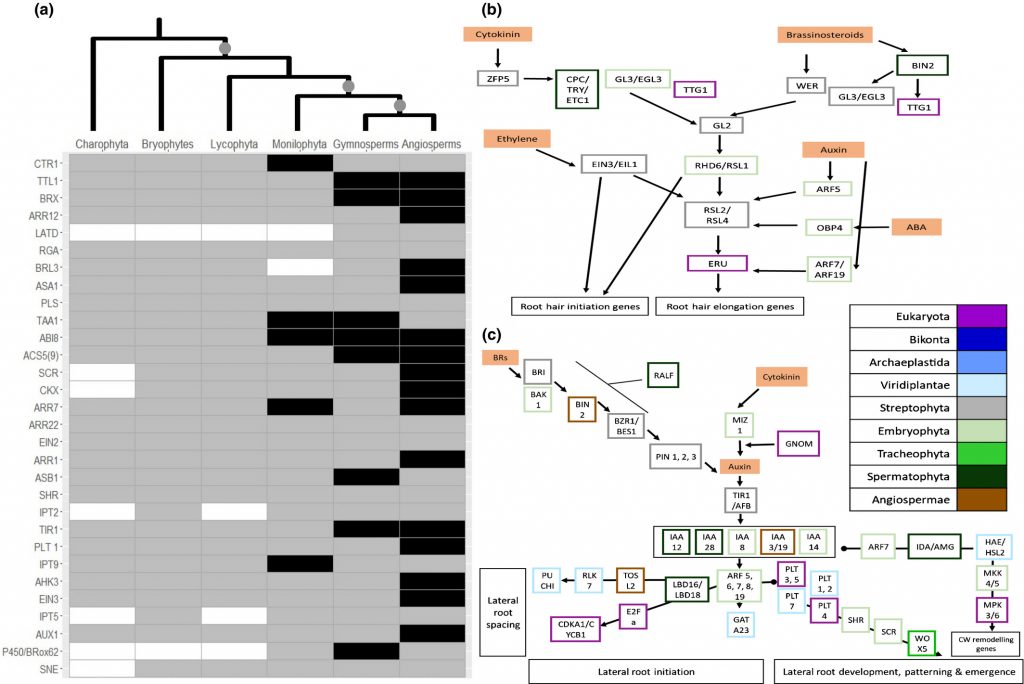 The availability of genome data from across the kingdom of plants has provided insights into plant evolution, and particularly the emergence of land plants. Here, Bowles et al. explore the genetic origins of three key innovations that supported the expansion of land plants: stomata, vascular tissues, and roots. They investigated the correlation between the emergence of key genes and the associated trait. For example, in some cased the genes predate the trait, and in others they coincide with trait emergence. This analysis demonstrates that the evolution of stomata strongly correlated with the emergence of novel genes, whereas genes involved in stomatal control emerged later than stomata. Conversely, key genes required for lateral root development predate this trait, and gene cooption was the major mechanism leading to the evolution of vascular tissues. As the authors observe, these deep insights into the origins of traits that first provided plants with the ability to thrive on dry land can be leveraged to develop plants with increased tolerance of drought. (Summary by Mary Williams @PlantTeaching) New Phytol. 10.1111/nph.17981
The availability of genome data from across the kingdom of plants has provided insights into plant evolution, and particularly the emergence of land plants. Here, Bowles et al. explore the genetic origins of three key innovations that supported the expansion of land plants: stomata, vascular tissues, and roots. They investigated the correlation between the emergence of key genes and the associated trait. For example, in some cased the genes predate the trait, and in others they coincide with trait emergence. This analysis demonstrates that the evolution of stomata strongly correlated with the emergence of novel genes, whereas genes involved in stomatal control emerged later than stomata. Conversely, key genes required for lateral root development predate this trait, and gene cooption was the major mechanism leading to the evolution of vascular tissues. As the authors observe, these deep insights into the origins of traits that first provided plants with the ability to thrive on dry land can be leveraged to develop plants with increased tolerance of drought. (Summary by Mary Williams @PlantTeaching) New Phytol. 10.1111/nph.17981
HSL1 and BAM1/2 impact epidermal cell development by sensing distinct signaling peptides
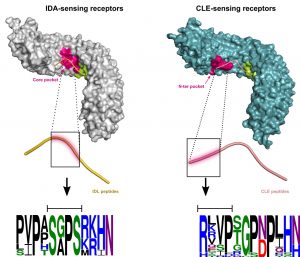 Cell-to-cell communication is crucial for coordinating plant immunity, development, and environmental adaptations. The main players in sensing signaling molecules are membrane receptor kinases such as Leucine Rich Repeat Receptor Kinases (LRR-RKs). In some cases these receptors detect peptide signals. INFLORECENT DEFICIENT ABCISION (IDA) and IDA-LIKE (IDL) are peptides sensed by the LRR-RKs HAESA (HAE) and HAESA-LIKE2 (HSL2) receptors. The LRR-RK BARELY ANY MERISTEM 1 (BAM1) and BAM2 are able to sense CLAVATA 3 (CLV3), a peptide which belongs to a family (CLAVATA3/EMBRYO SURROUNDING REGION-RELATED; CLE) that play important roles in many developmental processes. CLE peptides have a very similar sequence to IDA and IDL peptides. Previously, the interaction between CLE9 and HAESA/LIKE1 (HSL1) was shown to regulate the stomatal cell lineage development whereas the interaction between CLE9 and BAM1 regulates root xylem file number. In this work, Roman et al. describe that while CLE9 and IDA/IDL peptides are similar in terms of sequences, each peptide has its own specific and high affinity receptor, which are BAM1/2 and HSL1, respectively. Indeed, in leaf epidermal cell homeostasis, HSL1 and BAM1/2 may produce antagonistic results. Altogether, this works provides new insights in how the different specificities in ligand-receptor shape plant development. (Summary by Eva Maria Gomez Alvarez, @eva_ga96) Nature Comms. 10.1038/s41467-022-28558-4
Cell-to-cell communication is crucial for coordinating plant immunity, development, and environmental adaptations. The main players in sensing signaling molecules are membrane receptor kinases such as Leucine Rich Repeat Receptor Kinases (LRR-RKs). In some cases these receptors detect peptide signals. INFLORECENT DEFICIENT ABCISION (IDA) and IDA-LIKE (IDL) are peptides sensed by the LRR-RKs HAESA (HAE) and HAESA-LIKE2 (HSL2) receptors. The LRR-RK BARELY ANY MERISTEM 1 (BAM1) and BAM2 are able to sense CLAVATA 3 (CLV3), a peptide which belongs to a family (CLAVATA3/EMBRYO SURROUNDING REGION-RELATED; CLE) that play important roles in many developmental processes. CLE peptides have a very similar sequence to IDA and IDL peptides. Previously, the interaction between CLE9 and HAESA/LIKE1 (HSL1) was shown to regulate the stomatal cell lineage development whereas the interaction between CLE9 and BAM1 regulates root xylem file number. In this work, Roman et al. describe that while CLE9 and IDA/IDL peptides are similar in terms of sequences, each peptide has its own specific and high affinity receptor, which are BAM1/2 and HSL1, respectively. Indeed, in leaf epidermal cell homeostasis, HSL1 and BAM1/2 may produce antagonistic results. Altogether, this works provides new insights in how the different specificities in ligand-receptor shape plant development. (Summary by Eva Maria Gomez Alvarez, @eva_ga96) Nature Comms. 10.1038/s41467-022-28558-4
Misregulation of MYB16 expression causes stomatal cluster formation by disrupting polarity during asymmetric cell divisions
 Water loss during photosynthesis is limited by specialized plant cells such as stomata, as well as cuticle formation on the epidermis. In Arabidopsis thaliana, stomata lineage is a good system in which to elucidate the interplay between biochemical signals and mechanical properties during leaf development. In this study, Yang et al. explored the connection between cuticle formation and stomata development. Using live-imaging, cell-type-specific perturbations, expression assays, and transmission electron microscopy (TEM), they investigated the function of MYB16, a regulator of cuticle formation, in the role of stomata patterning. MYB16 is localized to stomata lineage ground cells (SLGCs) and meristemoids, but its expression in meristemoids is switched off when SPEECHLESS (SPCH) is present. MYB16 overexpression and ectopic expression lines increase the number of stomata, stomata cluster formation, and enhance the thickness in the cuticle. Moreover, ectopic MYB16 expression alters the polarity setup during asymmetric cell divisions. This work shows how the timing of cuticle formation is crucial for the correct stomata patterning. (Summary by Andrea Gómez-Felipe @andreagomezfe) Plant Cell 10.1093/plcell/koab260
Water loss during photosynthesis is limited by specialized plant cells such as stomata, as well as cuticle formation on the epidermis. In Arabidopsis thaliana, stomata lineage is a good system in which to elucidate the interplay between biochemical signals and mechanical properties during leaf development. In this study, Yang et al. explored the connection between cuticle formation and stomata development. Using live-imaging, cell-type-specific perturbations, expression assays, and transmission electron microscopy (TEM), they investigated the function of MYB16, a regulator of cuticle formation, in the role of stomata patterning. MYB16 is localized to stomata lineage ground cells (SLGCs) and meristemoids, but its expression in meristemoids is switched off when SPEECHLESS (SPCH) is present. MYB16 overexpression and ectopic expression lines increase the number of stomata, stomata cluster formation, and enhance the thickness in the cuticle. Moreover, ectopic MYB16 expression alters the polarity setup during asymmetric cell divisions. This work shows how the timing of cuticle formation is crucial for the correct stomata patterning. (Summary by Andrea Gómez-Felipe @andreagomezfe) Plant Cell 10.1093/plcell/koab260
GA-GRF module – A key regulator of rice leaf length via spatial cell division control
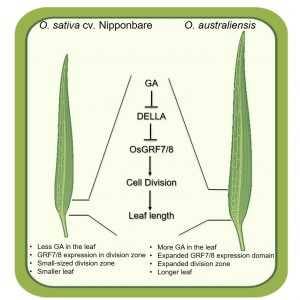 Leaf features have undergone significant changes during the course of evolution and domestication owing to ecological adaptations and changes in source-sink dynamics. Therefore, wild relatives of crop plants are important resources for exploring the genetic regulation of leaf features that might not be present in the cultivated gene pool. Jathar et al. have elucidated a key module explaining leaf length regulation in rice, utilizing the cultivated and wild rice accession showing contrasting differences in their leaf length. The study is important as the mechanism underlying the leaf size in monocots remains poorly understood in contrast to extensively studied leaf size regulation for simple Arabidopsis leaves and compound tomato leaves. The wild rice Oryza australiensis showed remarkably longer leaves and faster leaf elongation rate than cultivated rice Oryza sativa. Using the combination of transcriptomic profiling and leaf kinematics, the authors revealed that the levels of the hormone gibberellic acid (GA) have been strongly associated with the size of the division zone at leaf basal region, and thus leaf length. GA mediates cellular dynamics at the division zone via GRF transcription factors, OsGRF7 and OsGRF8. Given that the morphological variation in leaves is a crucial adaptation of plant response towards climate changes, the module could also be important for phenotypic plasticity under environmental fluctuations and could further be exploited to fine tune the leaf length to improve the physiological performance of the plants. (Summary by Prakshi Aneja @PrakshiAneja) New Phytol. 10.1111/nph.18029
Leaf features have undergone significant changes during the course of evolution and domestication owing to ecological adaptations and changes in source-sink dynamics. Therefore, wild relatives of crop plants are important resources for exploring the genetic regulation of leaf features that might not be present in the cultivated gene pool. Jathar et al. have elucidated a key module explaining leaf length regulation in rice, utilizing the cultivated and wild rice accession showing contrasting differences in their leaf length. The study is important as the mechanism underlying the leaf size in monocots remains poorly understood in contrast to extensively studied leaf size regulation for simple Arabidopsis leaves and compound tomato leaves. The wild rice Oryza australiensis showed remarkably longer leaves and faster leaf elongation rate than cultivated rice Oryza sativa. Using the combination of transcriptomic profiling and leaf kinematics, the authors revealed that the levels of the hormone gibberellic acid (GA) have been strongly associated with the size of the division zone at leaf basal region, and thus leaf length. GA mediates cellular dynamics at the division zone via GRF transcription factors, OsGRF7 and OsGRF8. Given that the morphological variation in leaves is a crucial adaptation of plant response towards climate changes, the module could also be important for phenotypic plasticity under environmental fluctuations and could further be exploited to fine tune the leaf length to improve the physiological performance of the plants. (Summary by Prakshi Aneja @PrakshiAneja) New Phytol. 10.1111/nph.18029
Mitochondrial retrograde signaling through UCP1-mediated inhibition of the plant oxygen-sensing pathway
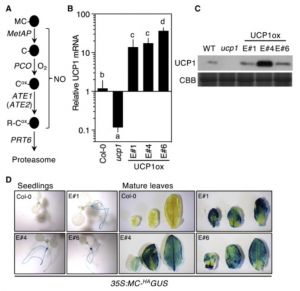 Plants have a plethora of oxygen requiring enzymes that are essential for survival. Mitochondria require oxygen to create ATP, yet during hypoxia they can alter gene expression in the nucleus through retrograde signaling, which may promote stress tolerance. Barreto et al. recently delineated a novel actor in the elusive signal transduction pathway in retrograde signaling by showing that overexpression of UCP1, an inner mitochondrial membrane protein, induces hypoxia gene expression in Arabidopsis nuclei. Overexpression of UCP1 promoted tolerance to high salt in seedlings and hypoxia in seedling root meristems. UCP1 inhibits the cytosolic plant oxygen-sensing PRT6 N-degron pathway, thus preventing proteasomal degradation of hypoxia-associated transcription factors, ERFVIIs, thereby increasing expression of two hypoxia gene markers. This work has revealed a novel actor in retrograde signaling during hypoxia, integrating mitochondrial oxygen consumption with cytosolic oxygen sensing machinery. Future work will examine the role of the multifunctional protein UCP1 in influencing mitochondrial signaling. (Summary by Orla Sherwood @orlasherwood) Curr. Biol. https://doi.org/10.1016/j.cub.2022.01.037
Plants have a plethora of oxygen requiring enzymes that are essential for survival. Mitochondria require oxygen to create ATP, yet during hypoxia they can alter gene expression in the nucleus through retrograde signaling, which may promote stress tolerance. Barreto et al. recently delineated a novel actor in the elusive signal transduction pathway in retrograde signaling by showing that overexpression of UCP1, an inner mitochondrial membrane protein, induces hypoxia gene expression in Arabidopsis nuclei. Overexpression of UCP1 promoted tolerance to high salt in seedlings and hypoxia in seedling root meristems. UCP1 inhibits the cytosolic plant oxygen-sensing PRT6 N-degron pathway, thus preventing proteasomal degradation of hypoxia-associated transcription factors, ERFVIIs, thereby increasing expression of two hypoxia gene markers. This work has revealed a novel actor in retrograde signaling during hypoxia, integrating mitochondrial oxygen consumption with cytosolic oxygen sensing machinery. Future work will examine the role of the multifunctional protein UCP1 in influencing mitochondrial signaling. (Summary by Orla Sherwood @orlasherwood) Curr. Biol. https://doi.org/10.1016/j.cub.2022.01.037
Metabolomic selection for enhanced fruit flavor
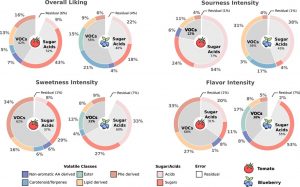 Breeding for flavor in fruits and vegetables is a dauting task. For several years, scientists have relied on consumer panels and instrumental analysis to make judgment calls on the flavor phenotype to select for during a breeding process. While these methods are often accurate and reliable, they are rigorous, costly, time-consuming, and difficult to scale to large breeding programs. But what if artificial intelligence could use metabolomic information to predict for flavor, just like genomic selection uses genomic information to predict complex traits? Here, authors Colantonio et al. used a combination of chemical and sensory information of tomato and blueberry to train machine learning models to predict how consumers will like the fruit. They evaluated different metabolite (sugar, acid, and volatile organic compounds) contributions to flavor and employed 18 statistical and machine-learning methods for accuracy in predicting these sensory traits. They show that sugars/acids are the main predictors of consumer liking and preference in blueberries, while volatile compounds contribute most to consumer flavor perception in tomatoes. Furthermore, they observed that machine learning tools are better predictors of flavor phenotypes compared to genomic selection. This work will help increase the efficiency of flavor phenotyping, and enable breeders to introduce flavor traits in the early phases of their breeding programs. Ultimately, it will facilitate the development of high-quality fruits and vegetables for consumers. (Summary by Modesta Abugu @modestannedi) PNAS 10.1073/pnas.2115865119
Breeding for flavor in fruits and vegetables is a dauting task. For several years, scientists have relied on consumer panels and instrumental analysis to make judgment calls on the flavor phenotype to select for during a breeding process. While these methods are often accurate and reliable, they are rigorous, costly, time-consuming, and difficult to scale to large breeding programs. But what if artificial intelligence could use metabolomic information to predict for flavor, just like genomic selection uses genomic information to predict complex traits? Here, authors Colantonio et al. used a combination of chemical and sensory information of tomato and blueberry to train machine learning models to predict how consumers will like the fruit. They evaluated different metabolite (sugar, acid, and volatile organic compounds) contributions to flavor and employed 18 statistical and machine-learning methods for accuracy in predicting these sensory traits. They show that sugars/acids are the main predictors of consumer liking and preference in blueberries, while volatile compounds contribute most to consumer flavor perception in tomatoes. Furthermore, they observed that machine learning tools are better predictors of flavor phenotypes compared to genomic selection. This work will help increase the efficiency of flavor phenotyping, and enable breeders to introduce flavor traits in the early phases of their breeding programs. Ultimately, it will facilitate the development of high-quality fruits and vegetables for consumers. (Summary by Modesta Abugu @modestannedi) PNAS 10.1073/pnas.2115865119



